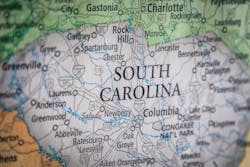Lake Greenwood WTP and Raw Water Intake: Teamwork Makes the Dream Work
Submission by Caroline Meiss
Edited by Mandy Crispin
“The Lake Greenwood WTP and Raw Water Intake is a unique Greenfield facility that exemplifies the tremendous synergy that the Harper/GMC team shared in project delivery,” said Caroline Meis of Harper/GMC. The scope of work at the 9MGD raw water intake pump station includes passive intake screens, raw water intake pumps, a pre-engineered metal building, and significant marine work. At the 4MGD water treatment plant, Harper installed an ozone generation and pretreatment system, Super P sedimentation system, Greenleaf filtration system, two pre-stressed clearwells, high service pump station, administrative building, and all associated chemical feed facilities.
GMC and Harper partnered with key equipment manufacturers and trade partners early to incorporate their expertise into the design. Our team evaluated the design conditions with the engineer and owner to communicate each team member’s approach.
Phase I consisted of population and flow projections, public involvement, permitting, hydraulic analysis, and piloting of four treatment technologies. Piloting occurred at the site of the future raw water intake site utilizing water drawn through an intake screen placed at the approximate location of the proposed future raw water screen. Raw water then underwent sedimentation/clarification treatment through either a plate settler or upflow clarification pilot unit. The pilot configuration then provided the flow to be diverted to either a multimedia filtration pilot unit or a membrane pilot unit. The pilot units operated for approximately 30 days during which time data was collected, analyzed, and interpreted. We then recommended a treatment technology for the proposed WTP.
Following this decision, Phase II consisted of producing project plans and specifications for a 4 MGD WTP with the ability to be high rated to 6 MGD and expanded to 18 MGD. The treatment plant features ozone pre-treatment for taste and odor, rapid mix and upflow clarification, multimedia filtration, two 750,000-gallon clearwells, and finished water pump station. Treatment operations are conducted from a 5,648 SF, two-story administration building. The first floor houses the chemical feed pumps and day tank storage, with bulk storage being housed outside for ease of access and delivery. The second story is highlighted by a control room with a SCADA system to monitor and control plant operations along with a laboratory for running tests relevant to the treatment plant.
Harper’s project management systems allowed them to achieve collaboration across the team and maintain safety standards throughout the course of construction.
For example, the administration building serves as chemical feed on the first floor and includes a lab, offices, conference room and break room on the second floor. This building included several architectural highlights as part of its design and construction. It consists of block walls with brick veneer, metal trusses with elevated concrete deck, light gauge framing, metal roof trusses, standing seam metal roof, exterior insulated metal wall panels, and glazed aluminum curtain walls.
Since there were several construction components and different trade partners installing them, Harper employed a third-party engineering firm to analyze the potential areas of concern for water infiltration. Harper, their trade partners, and GMC met to review the items, develop solutions as well as sequence of construction to develop an excellent building envelope. This collaborative approach gave the owner the architectural features they desired while making sure basic building functionality was achieved.
They achieved several other goals by emphasizing a safe job site, providing component testing and team education, maintaining milestones, and acknowledging a fair profit earned, not given. Experience shows that safety, owner goals, quality, schedule, and profit are interdependent. Safety is a direct indicator of quality, which combines to impact client satisfaction—emphasizing safety yields a higher-quality project.
In order to mitigate any safety risks, the team conducted training at the site which focused on the following topics: ladder safety; fall protection; respiratory protection; electrical and Lock-Out/Tag-Out (LOTO); swing stage scaffolding, lifeline, and rescue response; scissor/boom lift operator training; rigger and signaling training; forklift; earthmoving equipment; heat related illness prevention training; silica awareness training; first aid/ Cardiopulmonary Resuscitation (CPR)/Automated External Defibrillators (AED); hazard communication; ergonomic-related injury prevention; and emergency action plan with drills.
When a team does not cut corners on safety, this attitude permeates the rest of the project. Rework from improper installations and unqualified trade partners does not affect the schedule and profit. The project avoids negative press and community sentiment. Everyone leaves the project satisfied and looking forward to the next partnership opportunity.
Quality indicates how well each individual understands and executes the established goals. The team relentlessly reviewed constructability concerns, material compatibility issues, and sequencing flaws, if they arose.
During construction, quality was monitored daily by Superintendent, Jason Hammond. He facilitated and monitored a continuous punch list for Harper and each trade partner. Jason documented deficiencies and would issue a notice to the trade partner requesting a solution.
Additionally, maintaining the budget was a priority of the client for this project, so our team provided extensive value engineering and constructability reviews, resulting in a $1.4MM decrease in initial GMP during construction. This project was the first USDA-funded CM At-Risk infrastructure project, which required a lot of coordination with the funding agency. Continuous value engineering efforts gave LCWSC opportunities to prioritize and relocate funding as the design developed. Harper provided GMP estimates at 30%, 60%, and 90% design and committed to early procurement to lock in pricing and gain trade partner input. The team saved the client millions through well-developed value engineering methods.
In order to provide collaborative communication during the construction, the team focused on opportunities for all team members to engage across multiple departments to benefit from differing experiences and points of view from each member of the team. Availability, previous partnerships, expertise, and personality all factored into the team to collaborate with Laurens County Water & Sewer Commission and GMC.
The team devoted the beginning of the project to take the time to ask questions to understand LCWSC’s goals, concerns, and constraints. The purpose of these meetings is to ensure our plan reflects the objectives from day one.
After each meeting, the preconstruction team revised scope packages, solicited trade partner input, and updated the project GMP tracker which allowed LCWSC to see quotes, budgets, and decisions. They also captured wish list items that may be slightly beyond the project’s primary scope. Then the team actively viewed prices, selections, and alternates in an easy-to-understand format for each phase of the project.
Innovation and sustainability were important ideas and goals for the team to include for the owner with this project. One way they implemented this was with an Aqua-Aerobic ozone generation system. This technology was used at this plant and is a unique and innovative process, especially for construction in the Southeast. By utilizing this system, Harper was able to help address the small particulates that created taste and odor concerns that the client was previously experiencing that traditional filtrations systems cannot process. Mitigating these issues led to more satisfied LCWSC clients, and a higher quality of drinking water for the community.
This project occurred while COVID-19 conditions impacted supply chains and labor, offering additional challenges. By managing the team, projecting needs consistently, and emphasizing appropriate protocols, this project never shut down due to delays, staffing issues, or health concerns.
The team recognized lead times would be long for the primary equipment and that pricing could increase so they worked with LCWSC and GMC to research, price, and receive approval on the treatment systems during preconstruction. Early procurement ensured pricing didn’t increase on the major equipment and that equipment was onsite early, meaning Harper crews installed it when the schedule dictated, not the supply chain.
The owner utilized the Suez equipment package for the project, which is a complicated, proprietary system that is not seen in many plants in the Southeast. GMC and Harper partnered early with Suez to incorporate their knowledge into the design and their production timelines into the schedule. Including the equipment manufacturer early in the project allowed Suez to provide valuable input and begin production during preconstruction, instead of waiting for final GMP. This approach saved time and money for the owner and led to a successful integration at the plant.
Harper focused its goals with one major goal in mind—to treat drinking water for the Lake Greenwood community, which is supplied by the Saluda and Reedy River watersheds. The new technology installed at the WTP allows LCWSC to better treat and remove contaminates that have negatively impacted customers on a seasonal basis and positions LCWSC to better address emerging contaminants that EPA and DHEC could potentially regulate in the future.
The new WTP also allows LCWSC to predict and more directly manage costs passed on to customers for providing water service. Historically, LCWSC has purchased all its water from smaller local suppliers on a wholesale basis. Eventually, it will be more cost effective to manage their own water treatment expenses, allowing LCWSC to predict future needs solely for their system and minimizing unnecessary expenses unrelated their customers.
When coupled with the water capacity and water quality issues, the decision by LCWSC’s Board of Commissioners to fund such a large capital project sooner rather than later was a thoughtful and straightforward decision. Sustainability, water quality, and cost-efficiency were all given special consideration in this project. LCWSC ultimately determined Lake Greenwood, the largest source of raw water in Laurens County, was the ideal site for this project in order to accommodate potential growth and potential weather impacts, serve a much larger capacity, and offer a sustainable solution for potential disruptions.
Project Location: Waterloo, South Carolina
Project Size: 4 MGD WTP
Facility Size: 9MGD Pump Station
Budget Cost: $28,916,467
Project Owner/PM: KC Price
Project Designer: Tony Reid
Project Contractor: Harper General Contractors - Jared McMullan
Project Manufacturers: Suez, ITT Goulds, Xylem, Pinnacle



